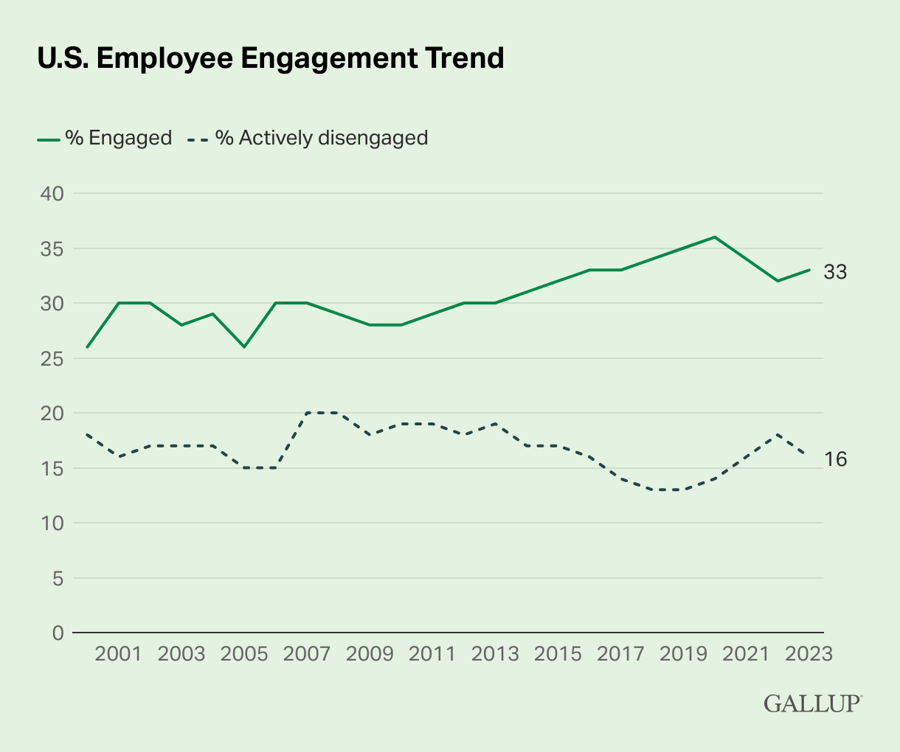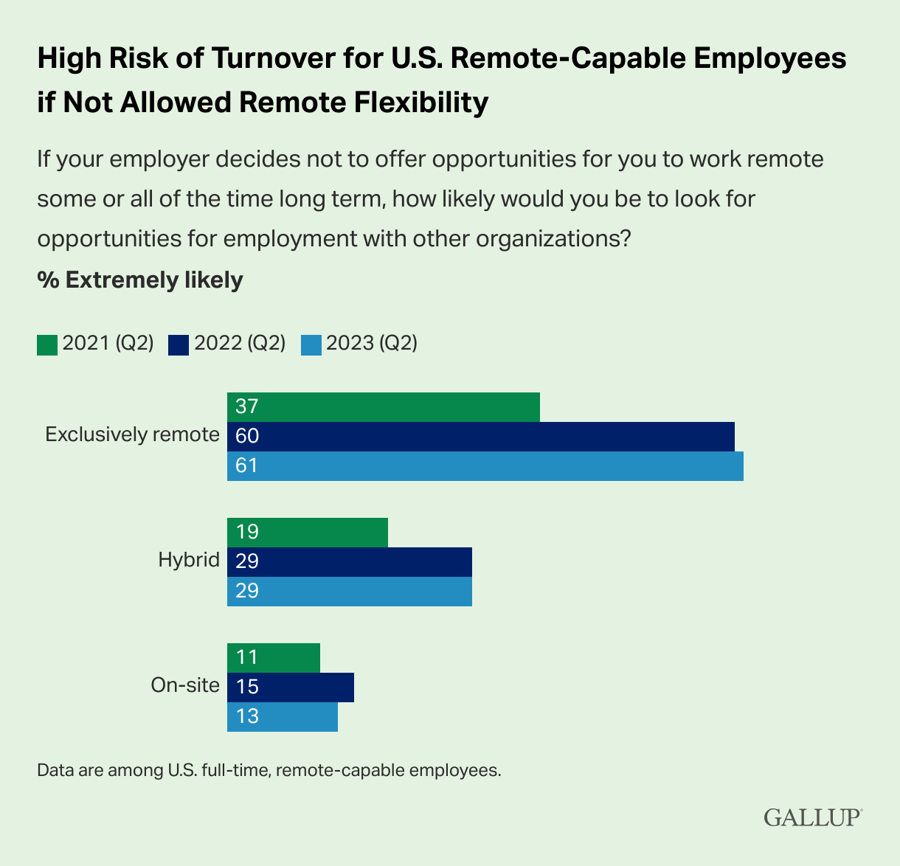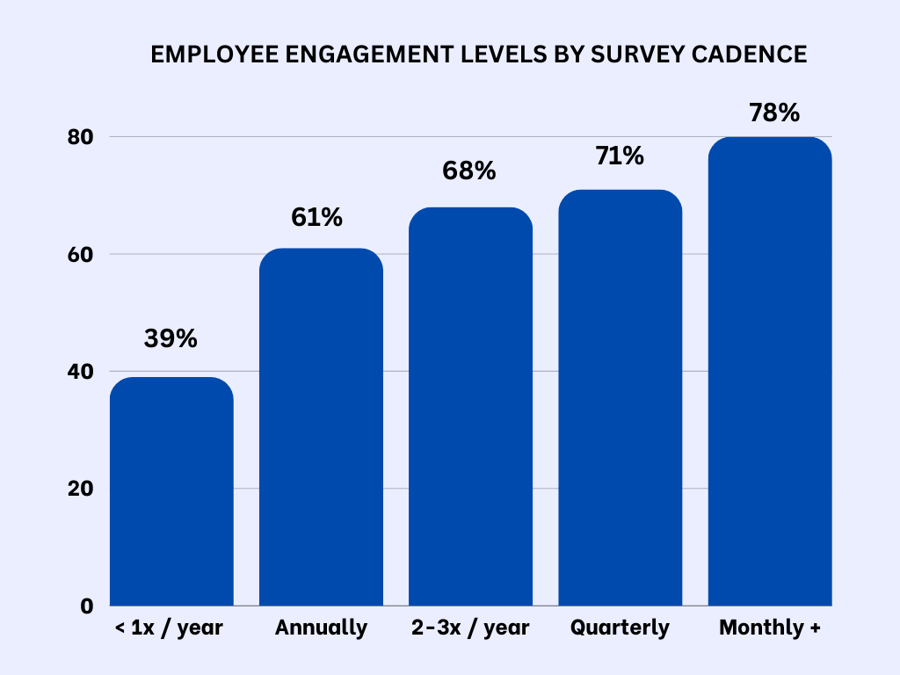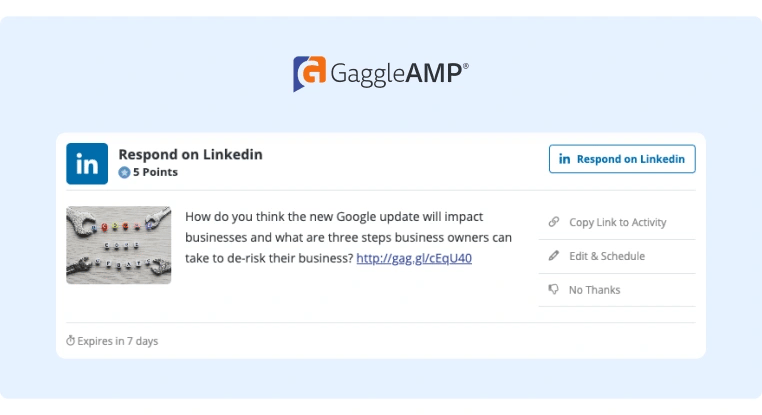How to Measure Employee Engagement (Accurately)
An engaged workforce is the core of a successful business. When your employees are engaged, they’re more productive and work harder toward increasing profitability. It’s vital to motivate your staff to go the extra mile and help your business prosper.
But, how do you know if your employees are highly engaged, moderately engaged, or disengaged? More importantly, how do you boost employee engagement?
Learning how to measure employee engagement is the first step toward improving it. However, measuring employee engagement can be challenging because it is the sum of multiple variables that are not always easy to quantify and analyze.
This comprehensive guide to measuring employee engagement will explain the various metrics for measuring employee engagement accurately and how to use them.
First, let’s define employee engagement.
What Is Employee Engagement?
Employee engagement is the connection employees have to their employer. It’s how committed they are to their work and workplace, how passionate they are about their responsibilities, and how motivated they feel about pursuing an organization’s goals.
But, employee engagement doesn’t tell the whole story. For instance, a happy employee seems engaged, always showing up for team dinners and training camps. But, they leave as soon as they get a more lucrative offer from a competing firm, and you’re left wondering what happened!
This is why measuring and tracking employee engagement effectively is important; you can’t rely on surface-level appearances.
Ideally, you want more than your employees to be happy –– you want them to be highly engaged and invested in the organization’s success. This increases job satisfaction and makes employees more likely to stay on with your business.
Why Is It Important to Measure Employee Engagement?
Measuring employee engagement gives insight into what your business is doing right (or wrong) and how it’s affecting your workforce.
Once you measure the engagement levels, you can determine your workforce’s level of engagement and satisfaction towards your business and identify how to boost them.
Here are a few more reasons why you need to measure engagement levels.
1. To Predict Future Performance
Employee engagement is a strong predictor of performance outcomes, especially during turbulent times such as pandemics, economic downturns, and geopolitical tensions.
After a steady decade of growth where engagement peaked at 40% in June 2020, employee engagement has been on the decline. In 2023, 33% of employees were engaged and the percentage of actively disengaged workers declined to 16%.

Engagement levels are a predictor of multiple business outcomes. When employees are not actively engaged or actively disengaged, this loss accounts for approximately $1.9 trillion in lost productivity nationally. It is also indicative of employee retention levels, both high and low.
2. To Retain Talent
When employee engagement is low, it’s a sign that your employees are looking for better opportunities outside of the organization.
But, what’s fueling the drop in employee engagement? Since 2020, employees have experienced a decline in the clarity of job-related expectations. When employees lose sight of what’s expected of them in the workplace, engagement drops.
According to a Gallup survey of managers, this drop stems from:
- Restructuring of teams with less familiarity with one another, which has created major complications (51%).
- Employees now have additional job responsibilities added to their plates (64%).
- Managers have had no formal training on how to lead a hybrid team (70%).
By addressing these issues, including clarifying job responsibilities and providing training, you can improve employee morale and stave off the employee churn rate.
3. To Create a Culture of Trust
When you ask employees for feedback about how the business operates, you make them feel heard and valued. It tells them that the top leadership genuinely cares about them as individuals and is invested in their professional and personal growth.
This makes them more committed to the team and less likely to leave for a bigger paycheck.
4. To Stay Ahead of Trends
Job market trends like quiet quitting and the Great Resignation can pose enormous challenges for recruitment teams. You can be better prepared for job market turbulence by studying employee engagement metrics and allocating resources accordingly.
When you see engagement dropping, you’ll know it’s time to step in and address the situation.
5. To Safeguard Downtime During Organizational Changes
Organizational changes can sometimes lead to unexpected, negative results such as increasing downtime or increasing turnover. For example, when a company decides everyone has to come back to work in person instead of working remotely, some employees might resist the move.

Source: Gallup
This might lead to them not doing their best work or even leaving. Measuring engagement helps companies see how employees feel about organizational changes big and small. That way, they can make sure everyone feels satisfied and productive, even during big adjustments.
Once you’ve measured your employees’ engagement levels, you can determine your workforce’s engagement and satisfaction with your business and identify ways to boost it further.
Now that we have a fair idea of why it’s important to measure employee engagement, let’s dive into how you can measure employee engagement.
Measuring Employee Engagement
Figuring out how to measure employee engagement is a complex task. While metrics like turnover and retention rates can be calculated using simple formulas, other considerations like job satisfaction are qualitative.
After all, employee engagement is an emotion, a state of mind, or a feeling of connection –– it’s difficult to place on a scale from zero to 10.
Each business is unique and requires a customized approach to identifying the strengths and weaknesses concerning its employee engagement score, employee engagement index, and employee engagement key performance indicators (KPIs).
Depending on your business needs and culture, you can rely upon a combination of the following best practices to measure employee engagement effectively.
1. Maintain Transparency
First, you need to be transparent about your plans. Let your relevant department heads (Human Resources, C-suite, Finance, etc.) and employees know your intention to measure engagement and what you intend to do with your findings.
Keeping employee engagement measurement transparent and inclusive helps get honest and constructive feedback from the team.
You can also share any goals you’re working on with them if you do not overcommit. The whole exercise can backfire and make staff lose trust in their leadership if they make big promises and fail to follow through.
It’s always better to underpromise and overdeliver instead of vice versa.
2. Identify Your Engagement Goals
Employee engagement goals are essential benchmarks that you can use to identify an engaged employee. They help you determine how close someone is to reaching your ideal level of employee engagement. Refer to our Employee Engagement Checklist if you feel stuck.
3. Use Pulse Surveys
Due to their short length, pulse surveys are a convenient way to collect employee responses to simple yet significant questions.
Short, frequent surveys can play a crucial role in an organization’s employee engagement strategy. You can use them to collect real-time and actionable feedback on any topic and track trends over time.
Here are three types of questions you need to include in your pulse survey:
-
Satisfaction Questions: Does your manager motivate you to perform your best?
-
Opportunity Questions: Do you find sufficient growth opportunities in the organization?
-
Alignment Questions: Do you feel your team considers your opinions before making a major decision?
While pulse surveys are a great way to find out your employees' views on just about any topic, you need more to measure engagement accurately. That includes viewing responses to a pulse survey in tandem with the findings from more personalized employee interactions, such as one-on-one meetings.
4. Set Up One-on-One Meetings
One-on-one meetings are the most meaningful and accurate method to get employee feedback. Whether in-person or virtual, they offer the space to ask employees detailed questions about their experiences. Make sure to look out for both verbal and non-verbal cues when gauging answers.
To get the best results and avoid wasting time, eliminate distractions and pre-plan your questions. Here are some questions you could ask:
- What is your favorite part about working with this organization?
- Describe the work culture here in three words.
- Which aspect of your department do you feel needs the most improvement?
Pay close attention to employees’ responses. What they say or what they don’t say can be telling!
When you set up individual meetings, you show employees that you are spending the time and effort to find out about their opinions and needs. The very act of conducting one-on-one meetings can boost engagement levels in an organization.
5. Create Focus Groups
Businesses can use focus groups to study their employees’ dislikes, preferences, and sentiments toward various internal matters. This is especially useful for larger companies where one-on-one meetings may not be practical.
When setting up a focus group, make sure to include a diverse set of employees from different departments and seniority levels to get a better idea of the overall workforce attitude. Ask open-ended and qualitative questions to get key insights that can help you determine your employee engagement levels.
6. Calculate Your eNPS
The employee net promoter score, or eNPS, is a scoring system used by employers to track and measure employee engagement and loyalty within an organization. Your eNPS is based on a single question asked to employees. For example, ‘On a scale from 0-10, how likely are you to recommend this company as a great place to work?’
Your eNPS is calculated based on the difference between the highest and lowest response (your most-engaged employees versus the least-engaged employees). This score helps you quickly determine your workforce’s overall engagement levels.
If you want to understand your score better, you can also follow up with an open-ended question. For example, ‘Why did you choose that particular rating?’
7. Implement Continuous Listening Strategies
Measuring employee engagement is not a one-off activity. You must constantly monitor employee feedback and update your engagement strategies to keep up with changing sentiments. Compare new results to previous benchmarks to monitor your progress and understand how your employee engagement levels have changed.
If you’re wondering how often to measure your employee engagement score, the short answer is frequently, but without over-taxing employees. Evaluations like pulse surveys can be carried out weekly, while focus group discussions can be conducted once every quarter.
Even if you have a highly engaged workforce, it can suddenly deteriorate if you don’t continuously improve your engagement strategies.
Use various employee engagement measurement tools available and keep communication channels open between management and employees. Remember, you must prioritize your workforce's well-being for your business to succeed!
8. Conduct Exit Interviews
An exit interview can help you understand why employees are voluntarily resigning from your organization. They are typically carried out by the human resources department and can take place in person, over the phone, or virtually.
Exit interviews provide you with valuable insights from departing employees about their experience with your organization. Since they are already leaving the job, they are more likely to be honest with their feedback and not worry about offending the management.
Some common exit interview questions you can ask are:
- Why are you leaving this role?
- Do you feel the organization supported your professional goals?
- Are you satisfied with the level of training you received while working here?
9. Conduct Stay Interviews
Far less common than exit interviews are ‘stay’ interviews. These are one-on-one interviews carried out with employees who have been working at the company for a long time and have shown their loyalty and commitment to its goals.
You can ask long-term employees about the specific aspects of your organization that have kept them from leaving. Remember to spend some time discussing areas of improvement within the company to better understand what your employees prioritize.
Now that we’ve gone over the best practices, let’s select the metrics you need to consider when measuring employee engagement.
Employee Engagement Metrics You Should Consider
To measure employee engagement at the workplace, you need to be familiar with the following key metrics that help create passionate and motivated employees:
1. Relationships With Managers and Colleagues
The average employee spends one-third of their life at work. When you spend that much time with your colleagues, you want to have a good relationship with them. That makes the relationships employees form at the workplace a decisive factor in how they feel about the organization.
Positive manager-employee relationships encourage a culture of productivity and cooperation among workers. In fact, the relationship with management is the top factor in an employee’s job satisfaction. Employees who feel well-supported by their manager are 3.4x more likely to feel engaged at work. Good managers support an employee’s growth at the workplace and help them overcome any obstacles that they might encounter.
Source: Gallup
Apart from the vertical relationship between managers and employees, you should also study the horizontal relationship among team members. Having a culture of respect and inclusivity among co-workers fosters teamwork, allows them to achieve goals faster, and drives innovation.
2. Job Satisfaction
Happy and fulfilled employees benefit employers as well. Individuals who are happy at work produce better results and are more engaged than their unhappy counterparts.
An employee’s job satisfaction is based on several external factors, including, but not limited to: benefits, compensation, working hours, the potential for professional growth, and the commute to the office. With the shift towards remote work, many employees also include the option for flexible or remote work as a key criterion in determining their job satisfaction.
3. Personal Growth and Wellness
47% of employees say they regularly feel stressed or overwhelmed at work, while over a quarter of respondents feel their employer doesn’t care about their mental health.
Employees want to work at an organization where their physical and mental well-being are prioritized. So, it’s no surprise that employees are moving towards jobs that provide a greater work-life balance.
4. Recognition
It’s difficult for an employee to feel passionate about their work if their efforts go unnoticed by their managers and colleagues. Recognizing employees who go the extra mile is a simple yet effective way to make them feel more engaged and valued.
The lack of recognition given to high-performing employees may not be intentional; managers may forget or just be too busy. However, it’s essential to acknowledge deserving employees, which encourages them to continue their hard work.
5. Turnover and Retention Rates
A high voluntary turnover rate is indicative of a disengaged workforce. It can cause delays in project deadlines, affect team morale, and generally prove costly for your business. Employees leaving also means you must dedicate extra time and resources to recruiting and training replacement staff.
You can calculate your employee voluntary turnover rate using the following formula:
Turnover rate = No. of employees who resigned voluntarily in a given period / total no. of employees in the workforce x 100
A high retention rate correlates with a highly engaged and happy workforce. Businesses strive for a high employee intention rate as it helps them save on hiring costs, boost productivity, and foster teamwork.
You can calculate your employee retention rate using the following formula:
Retention rate = Total no. of employees in the organization - No. of employees who quit in a given period / total no. of employees x 100
6. Absenteeism and Presenteeism
Measuring employee engagement goes beyond simply showing up to work. While high absenteeism (frequently missing work) can be a red flag, presenteeism can also be a concern.
Presenteeism describes employees who are physically present but not mentally engaged. They might be going through the motions but not putting in their best effort. This is harder to track but including both absenteeism and presenteeism can help identify underlying issues affecting engagement and address them before they snowball.
7. Internal Communication Effectiveness
Effective internal communication is crucial for a happy and engaged workforce. Employees need to feel informed about company goals, changes, and updates. Strong internal communication fosters trust, transparency, and a sense of belonging.
Here’s how you can measure the effectiveness of your internal communications, and in turn, employee engagement:
-
Survey Response Rates: High response rates to internal communication surveys or polls can indicate employee interest and trust in the information being shared.
-
Knowledge-Sharing Metrics: Track metrics like participation in internal knowledge-sharing platforms or wikis. This can show how effectively information is being disseminated across the organization.
-
Time To Understand New Information: Measure how long it takes for employees to grasp new policies, procedures, or company initiatives. This can help identify any communication gaps.
How Not To Measure Employee Engagement
Measuring employee engagement is akin to “taking your employees’ temperature.” It provides valuable insight into the health of your workforce, so you can keep it healthy.
But, using the wrong tool or technique to measure employee engagement can give you a misleading picture. Here are some common missteps to avoid:
1. Relying on One Metric
Engagement is a complex beast, influenced by many factors. Overreliance or relying solely on one metric, like surveys on satisfaction or absenteeism rates, can miss the bigger picture.
Instead, look for a combination of quantitative and qualitative data across categories to get a well-rounded understanding. Figure out which metrics are most relevant in revealing your employee engagement levels.
2. Waiting Too Long
Don't wait for morale to plummet before measuring engagement. Regular check-ins, like quarterly focus groups or weekly pulse polls, will allow you to identify issues early and address them before they escalate.
The graph below shows how employee engagement is affected by survey frequency.

Source: Formaloo
3. Survey Overload
Nobody likes to be bombarded with surveys. Frequent, lengthy questionnaires can lead to survey fatigue and decrease response rates.
Keep surveys concise, relevant, and action-oriented. Ask specific questions you can use to make real improvements.
4. Not Acting on Your Insights
Don't let your engagement data gather dust on a shelf. Once you have the results, analyze them thoroughly and identify pertinent trends. But, most importantly, take action!
Develop clear plans to address any issues and communicate those plans to your employees. Transparency builds trust and shows that you value their feedback.
The sooner you do this, the sooner you can make revisions to your plans.
5. Analysis Paralysis
Getting bogged down in over-analyzing data can be a trap. While it's important to understand the ‘why’ behind the numbers, don't get stuck in endless analysis.
Start by rigidly defining the scope of the data you’re gathering, selecting the specific metrics you are interested in, and creating a framework for how to respond.
Take clear, actionable steps based on your findings, and revise again later. Remember, progress over perfection!
How To Measure Employee Satisfaction
Employee satisfaction and employee engagement are oftentimes referred to as two sides of the same coin because they fuel each other. There is, however, a clear distinction between the two terms.
Employee satisfaction is more about contentment with specific job aspects like compensation, benefits, work-life balance, and workload. Despite that distinction, a lot of the best practices and methods for measuring employee engagement are the same as those for employee satisfaction.
Here are some additional ways to measure employee satisfaction:
-
Social Media Sentiment Analysis: While not a foolproof method, monitoring employee sentiment on company social media platforms (with their permission, of course) can reveal satisfaction trends.
-
Social Listening Platforms: Utilize dedicated social listening platforms to track employee mentions of the company on various online channels (review sites, forums, etc). Look for trends in satisfaction around specific aspects like work culture, workload, or career development opportunities.
-
Benefits Utilization Rates: Analyze how often employees utilize specific benefits. Low participation in wellness programs could indicate dissatisfaction with current offerings or a lack of awareness.
Giving honest feedback on job satisfaction can sometimes be difficult for employees due to fears of job security or retaliation. Always provide anonymous options for employee feedback to encourage honest responses, especially when using platforms like social listening or internal surveys.
How To Improve Employee Engagement Levels in Your Organization
We hope our guide to measuring employee engagement helps you create an effective strategy. Your goal should be to make the process as transparent and accurate as possible and use the results to drive positive change at the workplace.
If you’re looking for a solution to improve employee engagement across the company, consider GaggleAMP. Our employee advocacy platform encourages both internal communication and external sharing of their thoughts and voices on social media. It keeps employees updated on the latest news and events and helps them feel connected to the organization and its goals.

GaggleAMP Channels make it easy for employees to communicate with others, breaking down silos and forging a culture of teamwork and trust. The Channels are accessible from any mobile device and can be used to connect remote employees with ease.
Ready to boost your employee engagement levels with GaggleAMP? Start a free trial today.








